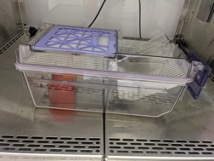Description
Material provided: Infected mouse tissue
Unit definition: Tissue from five mice
Biosafety Level: CL3
Installation name: Vectopole-Infected (IRD)
Website: www.mivegec.ird.fr
Short Description: Tissues from experimental infections of mice with Aedes infected with CL3 arboviruses (i.e., dengue, chikungunya, Zika virus, West Nile virus, yellow fever virus, Japanese encephalitis virus)
Description of the service
Arboviral transmission is ultimately defined by the ability of the virus to be transmitted to a mammal through biting. Successful bite-initiated infection depends on the mammalian host responses to biting, infection and salivary products. This response can take place at the skin during biting or later on in lymph nodes, which are secondarily infected after the skin, or other relevant tissues for infection such as liver or brain. The use of an animal model for arboviral transmission brings relevant information in the study of transmission.
We have optimized a system to infect mice through biting by single or multiple mosquitoes infected with different arboviruses. We control the number of mosquitoes that bite, where they bite and have a relative control over the infection level in mosquito saliva. We have different mosquito-arbovirus-mouse models. Using wild-type mice and Aedes aegypti mosquitoes, we can study the response to West Nile virus and chikungunya infection. Using immune-compromised transgenic mice and Aedes aegypti mosquitoes, we can study the previous viruses and also dengue virus, Zika virus, yellow fever virus and Japanese encephalitis virus. We can then dissect mouse tissues at different time points. We dissect skin, lymph nodes, liver, brain and other organs.
The product
The service we propose consists in infecting mice through biting, dissecting tissues and shipping in dry ice and in adequate security conditions the tissues of bite-initiated mice.
Publications
Xiang, Benjamin Wong Wei, Wilfried A. A. Saron, James C. Stewart, Arthur Hain, Varsha Walvekar, Dorothée Missé, Fréderic Thomas, et al. “Dengue Virus Infection Modifies Mosquito Blood-Feeding Behavior to Increase Transmission to the Host.” Proceedings of the National Academy of Sciences 119, no. 3 (January 18, 2022).
For more information, please contact us.

